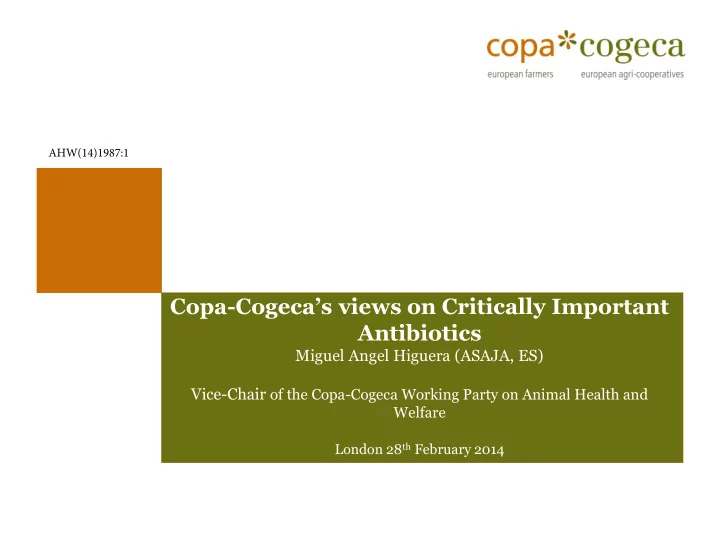

AHW(14)1987:1 Copa- Cogeca’s views on Critically Important Antibiotics Miguel Angel Higuera (ASAJA, ES) Vice-Chair of the Copa-Cogeca Working Party on Animal Health and Welfare London 28 th February 2014
Our main goal 1. Responsible and transparent use of antimicrobials Continue promoting good husbandry systems, biosecurity, feed hygiene, veterinary prescription Monitoring programmes on antimicrobials use/AMR Guarantee future treatments of bacterial infections in animals and humans 2. Improve availability of new antimicrobials Access to smart, effective and also alternative tools to cure our animals, including new diagnostic tools Copa-Cogeca | The voice of European farmers and their cooperatives | 2
Critically important antibiotics 1. Use of critically important antibiotics is low in most countries (3 and 4 generation cephalosporins and fluoroquinolones) (source: ESVAC 2011) 2. Science based decision making is key: Copa-Cogeca welcomes EC’s approach (EMA’s involvement) 3. A common EU approach is needed 4. Avoid quick decisions based on political pressure (e.g. target on use reduction) 5. Risk mitigations measures are part of the solution Copa-Cogeca | The voice of European farmers and their cooperatives | 3
Quinolones 1. Quinolone-resistant Salmonella and Campylobacter constitute a clear human health problem. 2. Epidemiological studies have shown, and biological reasoning indicates, a risk of treatment failure for quinolone-resistant Salmonella, leading to increased mortality in infected humans Copa-Cogeca | The voice of European farmers and their cooperatives | 4
Third and fourth generation cephalosporins 1. The evidence is slightly weaker. The evidence is only circumstantial. 2. This is not clear what role Extended Spectrum β -Lactamases (ESBLs) from animals and meat play in human health. 3. In some countries the same ESBL genotypes have been shown to occur in humans and in meat or animals 4. In other countries there are big differences in genotype distribution. 5. Biologically, cephalosporin resistance in Salmonella is a problem, since Salmonella infections in children can be treated with cephalosporins. Fluoroquinolones are not recommended as a first drug of choice in children Copa-Cogeca | The voice of European farmers and their cooperatives | 5
Macrolides 1. A picture more complicated 2. Macrolides are the drug of choice for Campylobacter 3. It could be argued that macrolides are critically important in poultry production, since poultry is a significant source of human campylobacteriosis, whereas pigs and pork are probably less significant and may not be significant at all. 4. It could therefore be argued that they are critically important when used in poultry, but not when used in pigs. Copa-Cogeca | The voice of European farmers and their cooperatives | 6
CIAs – which way forward ? (I) 1. Cephalosporins and fluoroquinolones should be excluded as a first drug of choice for clinical diseases both in individual animals and groups of animals …. unless clinical history or laboratory analysis indicates that they are needed. 2. Should the standard treatment fail where cephalosporins or fluoroquinolones are used as alternatives, bacteriological examinations should be performed to find alternative solutions. Copa-Cogeca | The voice of European farmers and their cooperatives | 7
CIAs – which way forward ? (II) 1. Specific antibiograms have to be considered during the use of third and fourth generation cephalosporins as well as fluoroquinolones on flocks or groups of animals 2. The antibiograms should confirm that there are no other alternatives and that these antimicrobials are the only way to treat and eradicate the disease. Copa-Cogeca | The voice of European farmers and their cooperatives | 8
CIAs – which way forward ? (III) 1. Copa-Cogeca calls upon the European Commission to ensure a broad and effective diagnostic system at Member State level to ensure the timely delivery of results • Time is different across MSs (e.g. from 4 days to even 4 weeks) 2. On farm cheap and effective diagnostic tools are desperately needed 3. Move forward from problem description to problem solving (e.g. HORIZON 2020) Copa-Cogeca | The voice of European farmers and their cooperatives | 9
CIAs – which way forward ? (IV) 1. Guidelines and recommendations suited for the particular disease and resistance situation in the country/production is essential for optimal choice of treatment 2. Responsible Use Guidance document - EPRUMA (European Platform for Responsible Use of veterinary Medicines), RUMA (UK), Vet+i (ES), …. 3. Knowledge transfer and education – veterinarians are responsible in taking the final decision 4. Veterinarians and farmers organisations have to continue to promote proper farm health management Copa-Cogeca | The voice of European farmers and their cooperatives | 10
Recent publication Available on our website in IT, EN, DE, PL, ES, FR, RO,
Copa-Cogeca: Defending and developing the European Model of Agriculture www.copa-cogeca.eu Copa-Cogeca | The voice of European farmers and their cooperatives | 12
Recommend
More recommend